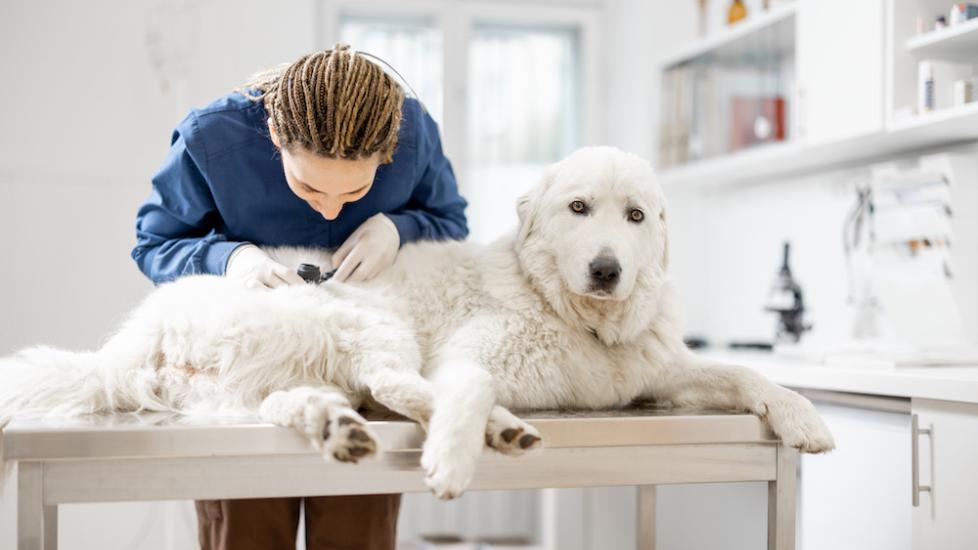Skin Tags on Dogs
What Are Skin Tags on Dogs?
Skin tags are small abnormal growths of skin. As the name suggests, they are skin that has grown differently than normal skin and are usually located on the chest, legs, and neck. Skin tags are not considered an emergency, but having your veterinarian examine them on their next annual visit is always recommended. You can also make a “skin journal” with location and size to help you remember before your next veterinarian visit.
What Do Skin Tags on Dogs Look Like?
Skin tags are usually not noticed until they are felt while petting or bathing your dog. Skin tags are very small pieces of skin attached by a small stalk-like structure. They are usually only a few millimeters in size, moveable, and not painful. They can be ether pink or darker in color. They can also occur alone or in a group.
Skin Tag Look-alikes
Ticks, masses, warts, and cysts can look like skin tags but they are different.
A tick might be tricky to confirm; if you do not notice legs extending from the body, do not try to remove it without a veterinarian accessing it first. Some cancers like melanoma can appear as a black skin tag and may also be easy to confuse.
Cysts of the skin are usually more attached and larger than skin tags. Cysts can be firm or soft, depending on what is inside. Some cysts can have a small attachment like a skin tag but will usually get larger over time. Warts are slightly raised, completely attached to the skin, and usually not moveable.
Be sure to monitor skin tags for any changes, and if you notice the growth changing, becoming larger, or you see many of them on your dog’s body, visit your veterinarian immediately in case a biopsy is needed.
Causes of Skin Tags on Dogs
Irritation
Skin tags are usually caused by chronic irritation. This is why they are seen most often in pressure areas such as the chest, knees, and elbows. Skin tags can also occur if a collar or harness rubs the skin repeatedly over time. Skin conditions caused by a flea allergy, food allergy, or environmental allergy can cause biting and scratching in one area, leading to a possible skin tag.
Virus
A papilloma virus can cause skin tag lesions. Papillomas usually cause warts, but on occasion they can cause skin tags in clusters. The papilloma virus is typically of no concern, and it is cured by removal of the skin tag or wart. If there are multiple skin tags that are bothersome to the dog, antiviral medications can be used.
Breed
Boxers, hound breeds, bully-type terriers, English Bulldogs, and Pugs are common breeds with skin tags. However, any breed can develop a skin tag.
How Veterinarians Diagnose Skin Tags on Dogs
Examination of the lesion by a veterinarian can usually provide a diagnosis. However, if the veterinarian is uncertain of the cause, a biopsy is needed. Biopsies are the only definite way to diagnose a skin tag.
In a biopsy, cells are removed from the lesion and sent to a laboratory for further diagnosis.
A pathologist at the lab will look for certain cells under the microscope to give a definitive diagnosis. Due to the small size of the lesion, removal may be needed to have enough of a sample to submit to the lab.
Treatment of Skin Tags on Dogs
No treatment is required if your dog is not bothered by skin tags. If they are the result of a virus, antiviral drugs can be prescribed to treat the lesions.
Surgical removal is the only cure for skin tags. Removal can be performed while under generalized or local anesthesia (where medicine is injected under the skin to decrease feeling in the area before cutting). Using a local anesthetic depends upon the location and size of skin tag, as well as the temperament of the dog.
Usually, skin tags are removed during another procedure such as a dental cleaning, spay, or neuter. Rarely does skin tag removal qualify for general anesthesia by itself unless a biopsy is needed for diagnosis. Surgical removal can be performed by excision or cauterization. Excision is cutting the attachment of the skin tag, and cauterization uses heat or electricity to burn the tissue attachment. A recovery cone or collar is recommended to prevent chewing of the area while it is healing.
Recovery and Prevention of Skin Tags on Dogs
Skin tags cannot be completely prevented, but some changes can help decrease the likelihood of developing them.
Prevention and management of skin tags requires much of the same care:
-
Soft, supportive bedding to decrease irritation when lying or getting up and down
-
Collars or harnesses can cause irritation; ensure they fit appropriately.
-
Treatment of allergies that are causing irritation to the area
-
Keep skin folds clean. MalAcetic and Mal-a-Ket wipes are examples of products that can be used to clean these areas easily.
Trauma can occur to skin tags at the groomer or during play. If that happens, treat it as a wound and seek appropriate medical care. Ensure that your groomer is aware of the skin tags so they are not accidentally cut.
Monitoring is always recommended, and it is helpful to use a journal to note the description and size of the skin tag each month. Inform your veterinarian of any changes on your next visit, or sooner if you see a cause for concern.
Featured Image: iStock.com/Adobe/rh2010
Help us make PetMD better
Was this article helpful?
